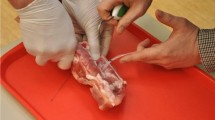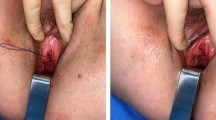Abstract
Introduction and hypothesis
The objective was to describe the fixation site of the anchor of the Ajust mid-urethral minisling.
Methods
This cadaveric study was based on a group of 11 formalin-embalmed bodies with legs positioned in 30° flexion and 30° abduction, and a group of five fresh-frozen bodies with legs positioned as normal during the procedure. The groups were later compared. The fixation site was dissected and described. The distance to the obturator bundle was considered as the primary safety parameter. To compare the groups of fresh-frozen bodies and formalin-embalmed bodies, the Student’s t test and Mann–Whitney test were used.
Results
In the group of formalin-embalmed bodies the mean distance from the anchoring device to the obturator nerve was 4.23 cm. In 19 cases out of 22 the anchor was within the complex of the obturator membrane and obturator muscles. In the group of fresh frozen bodies the mean distance to the obturator nerve was 3.15 cm. In 9 cases out of 10 the anchor was in the complex of the obturator membrane and obturator muscles.
Conclusion
The distance from the anchor to the obturator nerve was more than 2 cm in all cases. Correct placement in the obturator membrane was achieved in 65.6 % of cases. In 87.5 % of cases the anchor was placed within the complex of obturator membrane and obturator muscles.






Similar content being viewed by others
References
Roth TM (2007) Management of persistent groin pain after transobturator slings. Int Urogynecol J Pelvic Floor Dysfunct 18:1371–1373
Hazewinkel MH, Hinoul P, Roovers JP (2009) Persistent groin pain following a trans-obturator sling procedure for stress urinary incontinence: a diagnostic and therapeutic challenge. Int Urogynecol J Pelvic Floor Dysfunct 20:363–365
Meschia M, Bertozzi R, Pifarotti P, Baccichet R, Bernasconi F, Guercio E, Magatti F, Minini G (2007) Peri-operative morbidity and early results of a randomised trial comparing TVT and TVT-O. Int Urogynecol J Pelvic Floor Dysfunct 18:1257–1261
Kawaguchi M, Hashizume K, Iwata T, Furuya H (2001) Percutaneous radiofrequency lesioning of sensory branches of the obturator and femoral nerves for the treatment of hip joint pain. Reg Anesth Pain Med 26:576–581
Krofta L, Feyereisl J, Velebil P, Otcenasek M, Kasikova E, Krcmar M (2010) TVT-S for surgical treatment of stress urinary incontinence: prospective trial, 1-year follow-up. Int Urogynecol J Pelvic Floor Dysfunct 21:779–785
Oliveira R, Botelho F, Silva P, Resende A, Silva C, Dinis P, Cruz F (2011) Exploratory study assessing efficacy and complications of TVT-O, TVT-Secur, and Mini-Arc: results at 12-month follow-up. Eur Urol 59:940–944
Hubka P, Masata J, Nanka O, Grim M, Martan A, Zvarova J (2009) Anatomical relationship and fixation of tension-free vaginal tape Secur. Int Urogynecol J Pelvic Floor Dysfunct 20:681–688
Hubka P, Nanka O, Martan A, Grim M, Zvarova J, Masata J (2011) TVT-S in the U position–anatomical study. Int Urogynecol J Pelvic Floor Dysfunct 22:241–246
Ridgeway BM, Arias BE, Barber MD (2008) Variation of the obturator foramen and pubic arch of the female bony pelvis. Am J Obstet Gynecol 198(546):e1–e4
Bogusiewicz M, Rosinska-Bogusiewicz K, Drop A, Rechberger T (2011) Anatomical variation of bony pelvis from the viewpoint of transobturator sling placement for stress urinary incontinence. Int Urogynecol J Pelvic Floor Dysfunct 22:1005–1009
Hubka P, Doumouchtsis SK, Berger MB, DeLancey JO (2012) Variation of distances from mid-urethra to the obturator foramen: an MRI study. Int Urogynecol J Pelvic Floor Dysfunct 23:1075–1080
Abdel-Fattah M, Agur W, Abdel-All M, Guerrero K, Allam M, Mackintosh A, Mostafa A, Yousef M (2011) Prospective multi-centre study of adjustable single-incision mini-sling (Ajust(®) ) in the management of stress urinary incontinence in women: 1-year follow-up study. BJU Int 109:880–886
Hinoul P, Vanormelingen L, Roovers JP, de Jonge E, Smajda S (2007) Anatomical variability in the trajectory of the inside-out transobturator vaginal tape technique (TVT-O). Int Urogynecol J Pelvic Floor Dysfunct 18:1201–1206
Hubka P, Nanka O, Martan A, Svabik K, Zvarova J, Masata J (2011) Anatomical study of position of the TVT-O to the obturator nerve influenced by the position of the legs during the procedure: based upon findings at formalin-embalmed and fresh-frozen bodies. Arch Gynecol Obstet 284:901–905
Masata J, Martan A, Svabik K (2008) Severe bleeding from internal obturator muscle following tension-free vaginal tape Secur hammock approach procedure. Int Urogynecol J Pelvic Floor Dysfunct 19:1581–1583
Araco F, Gravante G, Sesti F, Piccione E (2009) Tension-free vaginal tape Secur hammock procedure: two additional cases of intraoperative bleeding. Int Urogynecol J Pelvic Floor Dysfunct 20:125
Hubka P, Svabik K, Martan A, Masata J (2010) A serious bleeding complication with injury of the corona mortis with the TVT-Secur procedure: two cases of contact of TVT-S with the corona mortis during cadaver study. Int Urogynecol J Pelvic Floor Dysfunct 21:1179–1180
Larsson PG, Teleman P, Persson J (2010) A serious bleeding complication with injury of the corona mortis with the TVT-Secur procedure. Int Urogynecol J Pelvic Floor Dysfunct 21:1175–1177
Andrada Hamer M, Larsson PG, Teleman P, Eten-Bergqvist C, Persson J (2011) Short-term results of a prospective randomized evaluator blinded multicenter study comparing TVT and TVT-Secur. Int Urogynecol J 22:781–787
Gobrecht U, Kuhn A, Fellman B (2011) Injury of the corona mortis during vaginal tape insertion (TVT-Secur using the U-Approach). Int Urogynecol J Pelvic Floor Dysfunct 22:443–445
Debodinance P, Amblard J, Lucot JP, Cosson M, Villet R, Jacquetin B (2009) TVT secur: prospective study and follow up at 1 year about 154 patients. J Gynecol Obstet Biol Reprod (Paris) 38:299–303
Cornu JN, Sebe P, Peyrat L, Ciofu C, Cussenot O, Haab F (2010) Midterm prospective evaluation of TVT-Secur reveals high failure rate. Eur Urol 58:157–161
Liapis A, Bakas P, Creatsas G (2010) Comparison of the TVT SECUR system “hammock” and “U” tape positions for management of stress urinary incontinence. Int J Gynaecol Obstet 111:233–236
Hinoul P, Vervest HA, den Boon J, Venema PL, Lakeman MM, Milani AL, Roovers JP (2011) A randomized, controlled trial comparing an innovative single incision sling with an established transobturator sling to treat female stress urinary incontinence. J Urol 185:1356–1362
Masata J, Svabik K, Zvara K, Drahoradova P, El Haddad R, Hubka P, Martan A (2012) Randomized trial of a comparison of the efficacy of TVT-O and single-incision tape TVT SECUR systems in the treatment of stress urinary incontinent women–2-year follow-up. Int Urogynecol J Pelvic Floor Dysfunct 23:1403–1412
Hubka P, Nanka O, Martan A, Svabik K, Koleska T, El Haddad R, Drahoradova P, Grim M, Zvarova J, Masata J (2010) Position of the TVT-O depending on the position of the legs. Joint annual meeting of the International Continence Society (ICS) and International Urogynecological Association (IUGA), Toronto
Atassi Z, Reich A, Rudge A, Kreienberg R, Flock F (2008) Haemorrhage and nerve damage as complications of TVT-O procedure: case report and literature review. Arch Gynecol Obstet 277:161–164
Acknowledgements
This study was supported by grant NT/14162 and projects of Charles University (UNCE 204013 and PRVOUK P35/LF1/5).
Conflict of interest
None of the authors had any conflict interest, except for A. Martan (preceptor of Gynecare, Bard).
Author information
Authors and Affiliations
Corresponding author
Rights and permissions
About this article
Cite this article
Hubka, P., Nanka, O., Martan, A. et al. Fixation of the Ajust minisling based upon cadaveric study. Int Urogynecol J 24, 2119–2123 (2013). https://doi.org/10.1007/s00192-013-2139-2
Received:
Accepted:
Published:
Issue Date:
DOI: https://doi.org/10.1007/s00192-013-2139-2




